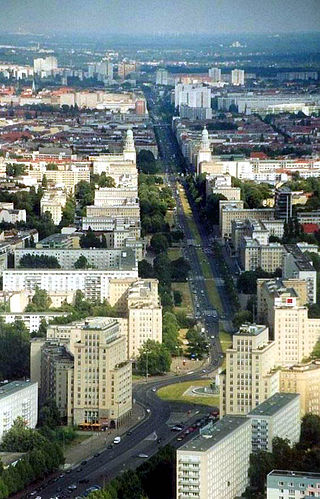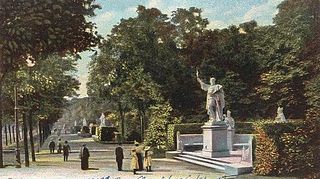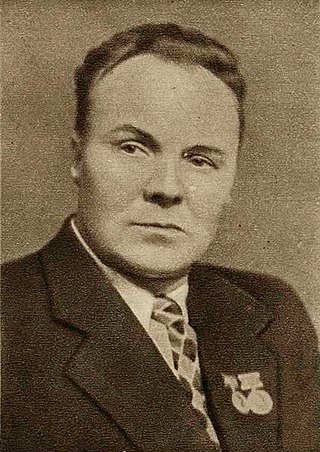
East Berlin was the partially recognised capital city of East Germany (GDR) from 1948 to 1990, although in 1945, it was recognised by the Three Powers as the Soviet occupation sector of Berlin. The American, British, and French sectors were known as West Berlin. From 13 August 1961 until 9 November 1989, East Berlin was separated from West Berlin by the Berlin Wall. The Western Allied powers did not recognize East Berlin as the GDR's capital, nor the GDR's authority to govern East Berlin. On 3 October 1990, the day Germany was officially reunified, East and West Berlin formally reunited as the city of Berlin.

Karl-Marx-Allee is a monumental socialist boulevard built by the GDR between 1952 and 1960 in Berlin Friedrichshain and Mitte. Today the boulevard is named after Karl Marx. It should not be confused with the Karl-Marx-Straße in the Neukölln district of Berlin.

The Siegesallee was a broad boulevard in Berlin, Germany. In 1895, Kaiser Wilhelm II ordered and financed the expansion of an existing avenue, to be adorned with a variety of marble statues. Work was completed in 1901.

The Oberbaum Bridge is a double-deck bridge crossing Berlin, Germany's River Spree, considered one of the city's landmarks. It links Friedrichshain and Kreuzberg, former boroughs that were divided by the Berlin Wall, and has become an important symbol of Berlin's unity.

Die Legende von Paul und Paula is a 1973 tragicomic East German film directed by Heiner Carow. A novel by Ulrich Plenzdorf named Die Legende vom Glück ohne Ende was based on this film.

Hermann Henselmann was a German architect most famous for his buildings constructed in East Germany during the 1950s and 1960s.

The Statue of Lenin is a 16 ft (5 m) bronze statue of Russian communist revolutionary Vladimir Lenin in the Fremont neighborhood of Seattle, Washington, United States. It was created by Bulgarian-born Slovak sculptor Emil Venkov and initially put on display in the Czechoslovak Socialist Republic in 1988, the year before the Velvet Revolution. After the dissolution of the Soviet Union, a wave of de-Leninization brought about the fall of many monuments in the former Soviet sphere. In 1993, the statue was bought by an American who had found it lying in a scrapyard. He brought it home with him to Washington State but died before he could carry out his plans to formally display it.

Nikolai Vasilyevich Tomsky was a much-decorated Soviet sculptor, designer of many well-known ceremonial monuments of the Socialist Realism era.

Peter Christian Breuer was a German sculptor.

The demolition of monuments to Vladimir Lenin in Ukraine started during the fall of the Soviet Union and continued to a small extent throughout the 1990s, mostly in some western Ukrainian towns, though by 2013 most Lenin statues in Ukraine remained standing. During Euromaidan in 2013–2014, the destruction of statues of Lenin become a widespread phenomenon and became popularly known in Ukraine as Leninopad, a pun literally translated as "Leninfall", with the coinage of "-пад" being akin to English words suffixed with "fall" as in "waterfall", "snowfall", etc.

The Berlin Stalin statue was a bronze portrayal of the Soviet leader Joseph Stalin. A Komsomol delegation had presented the sculpture to the East Berlin government on the occasion of the Third World Festival of Youth and Students in 1951. The monument was formally dedicated on 3 August 1951 after temporary placement at a location on a newly designed and impressive boulevard, Stalinallee, being constructed at the time in what was then the Berlin district of Friedrichshain. Stalin monuments were generally removed from public view by the leadership of the Soviet Union and other associated countries, including East Germany, during the period of De-Stalinization. In Berlin the statue and all street signs designating Stalinallee were hastily removed one night in a clandestine operation and the street was renamed Karl-Marx-Allee and Frankfurter Allee. The bronze sculpture was smashed and the pieces were recycled.

The Strausberger Platz is a large urban square in the Berlin district of Friedrichshain-Kreuzberg and marks the border to the district of Mitte. It is connected via Karl-Marx-Allee with Alexanderplatz and via Lichtenberger Straße with the Platz der Vereinten Nationen. These two streets intersect in an oval roundabout at Strausberger Platz.

De-Leninization is political reform aimed at refuting Leninist and Marxist–Leninist ideology, ending the personality cult of Vladimir Lenin, removing images and toppling statues of Lenin, renaming places and buildings, dismantling the Lenin Mausoleum currently in Red Square, Moscow, and burying his mummified corpse.

The Nikolai Vatutin monument was a sculpture monument to Soviet military commander Nikolai Vatutin, erected in 1948 and located in Mariinskyi Park, Kyiv, Ukraine, that was dismantled on 9 February 2023.

The Mykola Shchors monument was an equestrian statue to Red Army commander Mykola Shchors erected in 1954, and located at an intersection of Symona Petliury Street and Taras Shevchenko Boulevard, Kyiv, Ukraine, that was dismantled on 9 December 2023.

















